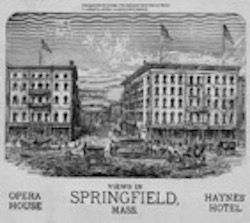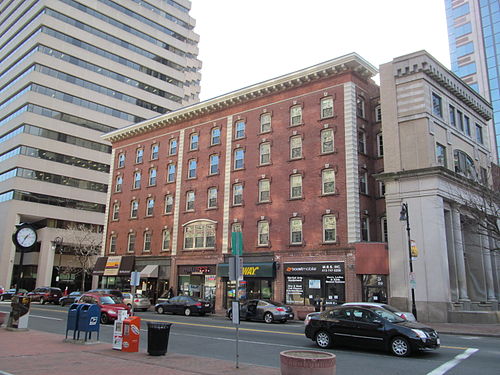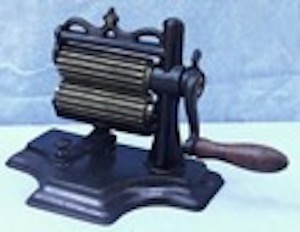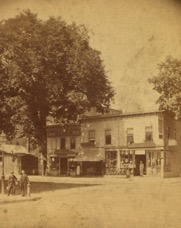Jane Maria Robinson Scottron
By Marla R. Miller
Jane Maria Robinson Scottron appears among the more than sixty dressmakers listed in Springfield city directory in the 1870-71 publication—coincidentally (or not) the first year that the publishers of the directory did not flag which of the city’s residents were “colored.”[1] If you didn’t already know that the Scottrons were a prominent, entrepreneurial family of African American barbers, hair dressers, and inventors, the presence of “Mrs. S. J. Scottron” in the long column of names under the heading “Dressmakers” in that year would not attract special notice. But readers in that year would have known that Jane Maria Robinson Scottron was among the city’s most successful Black businesswomen, present and working in Springfield from the 1860s, when she and her family settled there after the Civil War. Members of the Scottron family appear over 200 times in the Springfield Republican of the 1860s and 70s, the vast majority of instances being advertisements for their several businesses and services.
Jane Robinson was born in 1824 in Albany, New York, and married Samuel J. Scottron, a barber and baggage master on a boat that linked NYC and Albany via the Hudson River.[2] Like many African American families in the antebellum Northeast, the Scottrons moved among the region’s cities. They were in Philadelphia when son Samuel Raymond was born, but made their way to New York in 1849; between the mid 1850s and 60s, they were in mainly in Brooklyn. During the Civil War, Samuel J. Scottron launched a firm that provisioned a Black regiment from Pennsylvania; after the war son Samuel Raymond Scottron tried to launch some grocery stores in Florida, but after that enterprise failed, he and his parents settled in Springfield.


The family’s travels conferred a worldliness that the household hoped to parlay into profitable business enterprises. In 1867, the columns of the local newspaper noted that Samuel J. Scottron, “for so long a time barber on the Hudson River steamers,” brought to Springfield “what he claims to be the best barber chair in western Massachusetts,” which he installed in his son’s space in the Haynes Hotel Bathing and Shaving Rooms, a posh new five-story Italianate grand hotel.[3] The following summer, Scottron announced the opening of the “Emporium of Fashion” at 143 Main St, including a “first-class Barbering establishment” as well as “choice variety of Perfumery” and “fancy and useful articles.”[4] Jane and Melissa, for their part, established their businesses at 48 East Bridge Street.

Jane Scottron’s work as a dressmaker and hairdresser (undertaken in partnership with her daughter Melissa — who would go on to develop her own robust and long-lived business in haircare and beauty products), is well documented in the columns of the local paper; their many notices help us see that their enterprise was always diverse, encompassing several lines of activity.[5] For instance, the fashions of this period required “fluting” (that is, the creation of a series of fine pleats to fabric by applying a specialized iron). They also sold the device other women needed to do this work at home: Scottron’s earliest advertisements tout access to “best French Fluting machines — “a machine that will enable anyone to accomplish more work in a single hour than would formerly be executed by a skillful hand in a day.”[6] In September 1871 they announced a “handsome assortment of Stamps for Braiding and Embroidery, Wreaths and Initials for Pillow Shams” as well as “French Fluting, Costumes to hire, and all kinds of Masks for sale.”[7]A year later, when the pair informed readers that their enterprise had moved, they described their scope as “Hair Dressing, Dress Making, Braiding and Stamping.”[8]

The “handsome assortment of Stamps for Braiding and Embroidery, Wreaths and Initials for Pillow Shams” means the physical sale of goods: in the 1860s and 1870s, women purchased wooden stamps with which to transfer patterns on to fabrics.[9] They also provided “braiding and stamping with neatness and dispatch.”[10] Around this time they also advertised their ability to “make switches, chignons, frizettes, curls, etc.[11] Hairstyles in this period were highly elaborate. Mark Cambell’s book Self-Instructor in the Art of Hair Work Dressing Hair, Making Curls, Switches, Braids, and HairJewelry of Every Description (NY: M. Cambell, 1867) advised readers how to fabricate these articles, but experienced professionals like the Scottrons would have produced much more effective results. Switches — long falls of hair — were woven and sewn, while the cushion required for the base of a chignon was fabricated by short, waste hair and then covered with longer hair. Hair could be purchased by the pound, though customers also saved hair from their combs and brushes, and brought it in to be made into these hairpieces.[12] The Scottrons also “cut hair and shampoo.”[13]
This work taken all together apparently generated significant income: Samuel and Jane Scottron were people of influence and means. At least in December 1868, the Springfield Republican reported a break-in at their home, in which thieves took a gold watch worth $250. “The invaders,” the column reported, “had apparently made arrangements to steal several articles of clothing, including Mr. Scottron’s pants with his pocket book,” but were scared off.[14]Samuel J. Scottron and his son Samuel Raymond Scottron were among the leaders of the city’s Black community in this era, as founding members and officers of the groups including the Sumner Lodge No. 12 of the Free and Accepted Masons and the 1872 “Grant Club,” and as organizers of the citywide observation of the passage of the 15thamendment.[15]

Their thriving business would afford the family the claim to fame for which they are now best known. Jane’s son, Samuel Raymond Scottron, is well remembered today as the inventor of the “adjustable mirror,” patented in March 1868, while the family was living in Springfield.[16] While Scottron’s invention is generally framed as an idea born of his work as a barber, the image selected to accompany an advertisement for the device suggests that it could just as easily have come from or advanced his mother’s and sister’s work in both hairdressing and the clothing trades.
Though Jane Scottron’s earliest appearance in the city directory was among Springfield’s dressmakers, in time she shifted the emphasis of her work toward that of a “costumer” or sometimes “dressmaker and costumer.” In 1869, her son Thomas had announced that he “has now on hand a small assortment of Comic and Fancy costumes to rent to parties, balls, etc.,” but eventually, city directories and newspaper advertisements indicate that Jane Scottron took over this business, making, maintaining, and renting costumes.[17]
A sense of what the Scottrons offered is captured in a newspaper account of a Spring 1870 masquerade ball at the Springfield Armory, drawing some seventy-five couples, which reported that “some of the costumes were quite original and grotesque,” and that the “best costumes were furnished by Scottron” — (and, in a little dig to the neighboring city to the south) “though some of those from Hartford are probably called good enough in that city.”[18] Another advertisement noted that the business offered “costumes, masks, etc, in variety, suitable for parties and tableaux.”[19] Other notices suggest that the Scottrons hoped to supply people for “masquerades, fancy dress balls [and] ‘old folks’ concerts’ (popular events of this era, at which early American music was performed in period costume, suggesting something about Scottron’s inventory); a notice asking the “young lady who hired the swiss muslin ball dress for the Regatta Ball” suggest another sort of garment that was available.[20] When events were approaching across the city — from masquerades hosted by the City Guard to the Young Men’s Club Anniversary Ball — the Scottrons published advertisement reminding attendees that they could supply any attendee’s needs.[21] In 1873, Jane Scottron also sought and received permission to trade second-hand clothing, too, from her shop by that time over Dickinson’s Drug Store.[22]
A lawsuit that the Scottrons brought against the managers of St. Michael’s February 1871 Catholic Fair offers a glimpse into how the business operated.[23] The fundraising fair unfolded over much of the month and involved a series of events, from performances of the city band to lavish suppers. A local woman (Mary Cullinan) dressed as “Rebecca at the Well” – possibly based on Connecticut sculptor Charles Bradley Ives’ statue of the same year, depicting the Old Testament story in which the future wife of Isaac drew water from a well; she offered (temperance) beverages. The local paper reported that the event was a huge financial success — news that the Scottrons surely had tucked away when the dispute over payment arose. The family sued for “about $100,” the amount they believed was owed for costume rentals.[24] The fair’s managers claimed they had agreed to pay 57 cents per costume per use (and nothing if the costume was not worn), which was the “same arrangement as they made with other costumers in the city”; Scottron’s practice, however, was to charge 75 cents per costume per night — whether or not it was used. The discrepancy was considerable.[25]
In time, Jane and Samuel J. Scottron left Springfield. Their daughter Cordelia and son Samuel had each settled in Brooklyn, and in time Jane and Samuel joined them. A “Mrs. L.S. Booth,” who advertised herself as the “successor to Mrs. J. M. Scottron,” advertised in September 1873.[26] Melissa remained in Springfield, having in summer 1873 married James B. Adams, a member of another important African American family in Springfield.[27] (“M’dmes Scottron & Adams” offered “All kinds of Hair Work,” noting “combing” as a “specialty” in their shop at 458 State St. — that is, the Hancock Bank building).[28] A February 1889 advertisement notes that “Mrs. M. Scottron Adams, the well-known hair-dresser and shampooer,” has relocated to 25 Monroe Street, where she offers “Shower of Paris for the face, hair restorative and oil for dressing, solution for removing freckles or tan, olive balm for red or chapped hands and many other choice articles, all of the very best materials.”[29]
Jane Scottron died in Brooklyn in 1885.[30] But the family would continue to thrive, in a wide array of occupations. Of particular interest might be son Thomas, who became an actor, known in 1880 as “Boston’s Young Colored Tragedian;” a Boston Globe notice after his portrayal of Shakespeare’s Shylock observes that “Mr. T. C. Scottron’s interpretation of the treacherous traits of the miserly and murderous Shylock was in many respects superior to the rendition of some starts in the histrionic firmament.”[31] Between Jane’s work as a costumer and Thomas’ as an actor, and the family’s general engagement in the arts, perhaps it should be unsurprising that a descendant of this family — Jane Scottron’s great-great granddaughter — would go on to become one of the most celebrated performers of the twentieth century: the Grammy-award-winning singer, dancer, and actress Lena Horne.
Marla Miller is a historian of women and work in early America, at UMass Amherst; from 2001 to 2021 she directed the Public History program there.
[1] In 1872 she lists herself as a “costumer,” while Melissa is a “hair dresser,” though in 1873 she is once again a dress-maker. In 1874 she listed herself in a Brooklyn director as a hairdresser, but in 1877, she is again in Springfield, working as a hairdresser.
[2] See Springfield Republican, December 20, 1867.
[3]Springfield Republican, December 20, 1867.
[4]Springfield Republican, June 27, 1868.
[5] An advertisement in 1870, though, from “Scottron and Son,” “costumers,” thank customers for patronage and announce “additions to their stock;” see Springfield Republican, March 24, 1870. “The participation of free black women in the antebellum hair care business has been overlooked in the emphasis placed on black men as barbers” Walker, 182. Walker continues: “The three Remond sisters, Cecilia RemondBacock (?-‘9’2), Maritcha (,8,6-95), and Caroline Remond Putnam (,826-‘908), established their hairdressing enterprise, the Ladies Hair Work Salon, in Salem, Massachusetts. They also opened a wig factory, which became the largest enterprise of its kind in the state. In addition, they manufactured a tonic for hair loss, which they marketed as Mrs. Putnam’s Medicated Hair Tonic.While some of their sales were local, most of their business was done through their mail order service that covered several states in New England.”
[6]Springfield Republican, August 25, 1869: the enterprise also advertised French fluting and pinking done at short notice,” and sold the “celebrated Javelli Water, for bleaching linen and white goods.” Their shop was located at 48 Bridge St.
[7]Springfield Republican, September 30 1871; another advertisement, in the Springfield Republican March 21, 1871, mentioned “new and choice fancy costumes.”
[8]Springfield Republican, September 16, 1872.
[9]Sheryl De Jong, “What are these curious blocks in our textile collection?” O Say Can you See: Stories from the Museum, National Museum of American History, April 5, 1806: https://americanhistory.si.edu/blog/what-are-these-curious-blocks-our-textile-collection. Where the Scottrons sourced the blocks in their inventory is not yet known, but a New York City firm seems likely.
[10]Springfield Republican, September 28, 1872.
[11] Mark Campbell, Self-Instructor in the Art of Hair Work, Dressing Hair, Making Curls, Switches, Braids, And Hair Jewelry of Every Description (New York: 1867), A “switch” was a length of cut hair that was stitched together to work into hairstyles; a “frizette” was a pad, made of hair silk, which could add volume or shape. Today’sconsumers still want these same products, and can buy them on Etsy and elsewhere.
[12] Also, in Salem, MA Caroline Remond Putnam and her two sisters ran the largest wig factory in Massachusetts Dorothy Burnett Porter, “The Remonds of Salem, Massachusetts: A Nineteenth-Century Family Revisited,” Proceedings of the American Antiquarian Society.
[13]Springfield Republican, September 28, 1872.
[14]Springfield Republican December 10, 1868. See also December 14 1868 for an advertisement offering a $100 reward, “no questions asked.”
[15]Springfield Republican, June 22, 1869, June 23, 1869, Dec 4, 1869, Feb 26, 1870.
[16] This and below from Gail Lumet Buckley, The Hornes: an American family (New York : Alfred A. Knopf, Distributed by Random House Inc. 1986); “Samuel R. Scottron, 1843–1905, Inventor, entrepreneur,” on Encyclopedia.com: https://www.encyclopedia.com/african-american-focus/news-wires-white-papers-and-books/scottron-samuel-r; and Euell A. Nielson,“Samuel Raymond Scottron (ca. 1843-1905), https://www.blackpast.org/african-american-history/scrottron-samuel-raymond-1843-1905/. See also “The mystery of Samuel R. Scottron,” https://campbellhousemuseum.wordpress.com/2017/02/27/the-mystery-of-samuel-r-scottron/
[17]Springfield Republican March 8, 1869. Thos C. is described as “colored” in the city directory, and white in the US Census of 1870. In that year he lived in the household of Frank Hamilton, a 29 year old waiter from Florida. Cite to city directories. See Fashioning the Victorians: A Critical Sourcebook (2018).
[18]Springfield Republican, March 11, 1870.
[19]Springfield Republican, September 16, 1872; Springfield Republican, September 28, 1872.
[20] Springfield Republican, February 22, 1873; July 26, 1873.
[21]Springfield Republican Jan 24, 1871, Jan 29, 1872, Feb 22, 1872.
[22]Springfield Republican, February 4, 1873.
[23] The fair is described in the Springfield Republican, February 2, 6, 9, and 10, 1871.
[24]Springfield Republican, October 23, 1872. Craftwork, like the “elegant wreath of embroidered artificial flowers” contributed by a Mrs Smith (Feb 4), was offered for display and sale.
[25]See city directories, e.g. 1873-74. No additional information about the course case has yet been located: the newspaper reported that a court date had to be postponed due to Scottron’s ill health, and no further word of the matter appears. This resonates with the findings of historical archaeologist Paul Mullins, who has found that Black families relied more than White families on commercially packaged goods, which he speculates may have been a strategy to avoid the risk of a White grocer putting a “thumb on the scale:” per costume/per day seems more straightforward than “per use” and might have been a similar attempt to address ambiguity. See Paul R. Mullins, “Race and the Genteel Consumer: Class and African-American Consumption, 1850-1930,” Historical Archaeology 33, no. 1 (1999): 22-38.
[26]Springfield Republican Sept 8, 1873.
[27] They married August 19, 1873; see Massachusetts, U.S., Marriage Records, 1840-1915, via Ancestry.
[28]Springfield Republican Dec 2 1876.
[29]Springfield Republican Feb 13, 1889.
[30] They seem to show up in the census twice, in Springfield and Brooklyn both.
[31]Springfield Republican, March 15, 1880. See also Errol Hill and James v. Hatch, A history of African American theatre (Cambridge ; New York : Cambridge University Press, 2005).
4 replies on “Jane Maria Robinson Scottron”
Your informative article mentions fluters; and in particular the Peerless Fluting Iron along with a photograph of it. What is the relationship of this particular fluter to this family? Did they invent it or sell them as agents of some firm? I have a Peerless Fluting Iron, but cannot find ANY information about it.
Thanks for your question! I believe they were Peerless agents. An 1870 newspaper ad (Springfield Republican, Jan 19) from Mrs Scottron “begs leave to inform the ladies of Springfield and vicinity that she is prepared to receive their orders for the Peerless Fluting Machine, the best in the market, it having three different sized rollers.” Another (June 8) seeks to “inform ladies” that they are “able to take their orders and furnish them with a Peerless Fluting Machine, the best now in use.” I don’t know where the company was based or how the sales system worked; I’d love to learn more about that.
These are my ancestors. My maternal grandmothers maiden name is Thomas Owens Scottron. His father is Thomas C Scottron
Oh, goodness — Would love to connect with you and learn more!